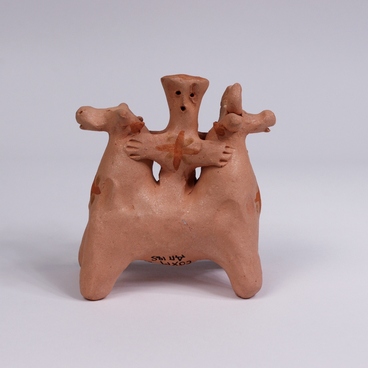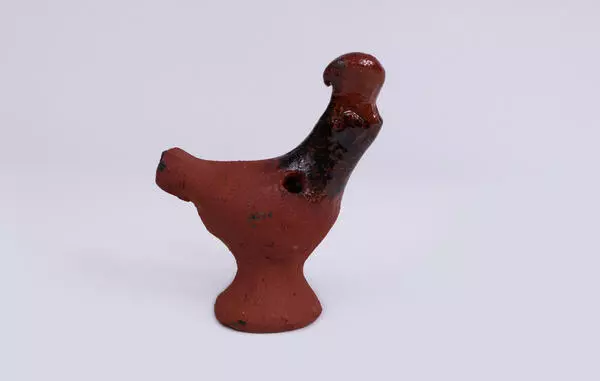‘Cossack on a Horse’ is an important theme for a traditional Sudzha toy. The city of Sudzha has long been a Cossack settlement. It was mainly inhabited by Sudzha Circassians — the Cossacks who served in the army. They served in the Sumy Cossack regiment and at the same time had plots and cultivated land. Therefore, the image of a dashing Cossack on a proud steed was especially popular here.
Burghers who were engaged in trade and crafts also settled in Sudzha. There were also peasants and gypsies among the settlers. All the inhabitants were mostly engaged in agriculture and honey hunting, but pottery also flourished. Sudzha was famous for its painted vessels produced in different shapes, sculptures, stove tiles, and construction ceramics. Potters’ families would also make toy whistles.
The Sudzha toy has an elegant shape and it is also interesting in terms of coloring. It can be glazed, slip-painted, smoked, and painted with dyes. The glazed technique means that the toy is dipped in a special glaze or it is poured from above. After firing, the coating looks like the thinnest colored glass. Slip painting is painting with clay diluted to the consistency of cream. Natural clays have different shades and can become richer or warmer in color when fired. By combining different clays and adding pigments to them, one can obtain amazingly subtle shades. A smoked toy implies that the firing process is carried out in a special way, without access to air — in such conditions, the figure becomes dark.
A hereditary potter Yury Spesivtsev made this Cossack on a horse. The master is skilled in all types of baking and decoration, traditional for Sudzha. He helped his father and grandfather since childhood. He had to work hard to join the prestigious profession of that time. He was not allowed to use a potter’s wheel right away. At first, the apprentice had to be ‘on hand’ for four years: knead clay, chop wood for firing toys, and dry the tableware. Yury Spesivtsev went through all these stages, and now he is known throughout Russia and abroad.
Burghers who were engaged in trade and crafts also settled in Sudzha. There were also peasants and gypsies among the settlers. All the inhabitants were mostly engaged in agriculture and honey hunting, but pottery also flourished. Sudzha was famous for its painted vessels produced in different shapes, sculptures, stove tiles, and construction ceramics. Potters’ families would also make toy whistles.
The Sudzha toy has an elegant shape and it is also interesting in terms of coloring. It can be glazed, slip-painted, smoked, and painted with dyes. The glazed technique means that the toy is dipped in a special glaze or it is poured from above. After firing, the coating looks like the thinnest colored glass. Slip painting is painting with clay diluted to the consistency of cream. Natural clays have different shades and can become richer or warmer in color when fired. By combining different clays and adding pigments to them, one can obtain amazingly subtle shades. A smoked toy implies that the firing process is carried out in a special way, without access to air — in such conditions, the figure becomes dark.
A hereditary potter Yury Spesivtsev made this Cossack on a horse. The master is skilled in all types of baking and decoration, traditional for Sudzha. He helped his father and grandfather since childhood. He had to work hard to join the prestigious profession of that time. He was not allowed to use a potter’s wheel right away. At first, the apprentice had to be ‘on hand’ for four years: knead clay, chop wood for firing toys, and dry the tableware. Yury Spesivtsev went through all these stages, and now he is known throughout Russia and abroad.



